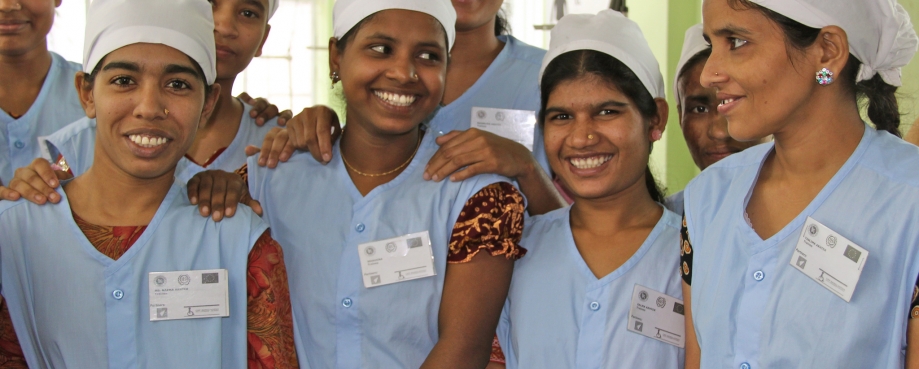
Monday sees the fourth anniversary of the Bangladesh Rana Plaza factory complex collapse. In this guest blog, Owen Tudor who is Head of the TUC’s EU and International Relations Department and an ETI Board Member, explains from a workers' representative perspective how prompt union action earlier this month helped prevent what could have been another horrifying industrial accident. At a Dhaka factory supplying several international retailers.
On 24 April 2013, the Rana Plaza factory complex collapsed, killing over 1,100 mostly women workers.
Subsequently, Bangladeshi and global unions took a lead in persuading multinational enterprises to join the Bangladesh Fire and Building Safety Accord and commit to trade union rights, to prevent Rana Plaza ever happening again.
Four years on, the case of the Ananta textile factory in Dhaka suggests that this approach is working; on this occasion saving 3,000 workers from potentially suffering the same fate as Rana Plaza’s workforce.
At 5 pm on Wednesday 5 April, a two-storey brick structure (where the factory guards were stationed) adjoining the Ananta Apparel factory on Elephant Road, Dhaka collapsed.
Cracks also appeared in the 15-storey reinforced concrete building producing ready-made garments for several global brands. Ananta’s seven companies exported $240m of garments last year.
The cause of the problems was an excavation site next door.
Union raises alarm
Unlike Rana Plaza where the absence of a union meant that the workers (afraid of losing their pay or even their jobs) re-entered the building when management told them to, at the Ananta factory TUC partner the National Garment Workers Federation (NGWF) organises the workers through the Ananta Fashion & Apparels Workers Union (AFAWU).
AFAWU leaders called on factory owners to evacuate the building.
Management agreed and after just 15 minutes the factory was closed for two days.
NGWF Organising Secretary Rafiqul Islam Rafique immediately met with the workers who remained worried about the timeframe. They decided to demonstrate the next day at the headquarters of the Directorate of Inspector General of Factories & Establishment (DIFE), the government department responsible for factory safety. They wanted to convince the DIFE to close down the factory's units until complete structural remediation.
The NGWF also contacted the Accord to investigate the state of safety and security at the Ananta building.
Next morning, hundreds of the Ananta workers paraded to the DIFE building and blockaded the offices, demanding that the Inspector General of Factories & Establishments (IGFE) send an official team to inspect the Ananta site.
Then the workers, in a procession, went to the head office of the Bangladesh Garment Manufacturer & Exporters (BGMEA), the apex body of the country’s factory owners, to press home the union’s demands, including factory closure, salary compensation and continuity of service.
Engineers visit factory
On the same day as the demonstration, 6 April, the Accord dispatched a team of structural engineers and remediation experts to visit Ananta. They issued a closure notice declaring the building unsafe for workers and production and told the factory management to carry out four emergency remediation steps.
The DIFE likewise issued a notice of factory closure till structural remediation of the Ananta Plaza made it safe for human occupancy.
Meanwhile, in compliance with the Accord's instructions, management started filling and compacting the excavated area and the cracks, using 40,000 cubic feet of earth and sand.
On 10 April, the factory announced that the emergency remediation was complete and that the site had been announced safe by engineers from the Bangladesh University of Engineering & Technology and officials of DIFE.
Management asked the workers to return to work but they were still apprehensive, so the NGWF and management simultaneously requested the Accord to re-investigate, which they did the next day.
Return to work
After a meeting with the workers, the NGWF and AFAWU agreed to a return to work on 12 April, with management, BGMEA and Accord in attendance as workers re-entered the building.
At 8 am on the morning of the return to work, the NGWF, factory union, management, BGMEA and Accord officials, including structural engineers, met at the factory before production recommenced.
The meeting resolved that the factory management would pay salary compensation to the workers for the days it was closed and that there would be no victimisation of workers for their actions.
Management also committed to complete the remediation of the building complex as recommended by the Accord as early as possible.
Successful relationships
The NGWF, its factory union and the Ananta workers had successfully worked with the Accord and the Government department concerned to ensure management closed the factory until the completion of emergency remediation.
NGWF’s Shahidul Islam Shahid, who provided much of the information in this blog, told the TUC, “This is a great victory for the workers, the union and the NGWF and a testimony of the success of the partnership between trade unions and the Accord.”
An earlier version of this blog was published on the TUC’s Stronger Unions website on 14 April 2017.
Correction 24 April: Some of the actions were originally attributed to the wrong days and/or dates which have now been corrected.
The image of trainee sewing machine operators is courtesy of the ILO and is not of workers at the Ananta factory complex.
